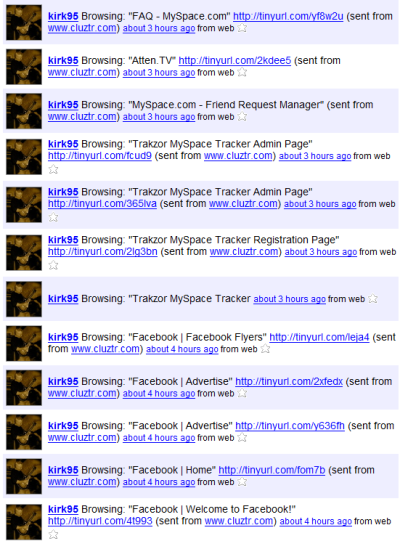Last week I wondered if clickstreams would be the next step in blogging, given the newfound popularity of twitter and the emergence of companies like Me.dium and Cluztr.
Turns out that Cluztr has a feature to turn your clickstream into twitter posts, and turns out that this combination is quite annoying. My friend David Henderson turned on this feature without realizing what it would do, and this morning my phone was overrun with SMS messages of his surfing. Here’s what it looked like:

It’s clear you don’t want to get an SMS whenever a friend views a web page. So the question becomes, what is the right way to filter this information? The native presentation modes of me.dium, atten.tv, and cluztr are certainly better than SMS. But it still hasn’t totally clicked with me; we need a way to distill and filter this information. This is a nut that is yet to be creacked!
Interesting ideas. But I think publishing clickstream data is only a fraction of the emerging “nano-blogging” picture.
As Twitter is enabling, you first need to figure out a way to nano-blog, or give a “status shoutout”, along a timeline that’s seamlessly online and offline (because your life is).
Then, for the online bit, you need your clickstream data presented “nicely”, with contextual commentary (“I’m at this URL. It’s cool”), rather than just a long line of URLs.
You also need to be able to control which of those URLs you chose to nano-blog about (to your point; a published complete-clickstream is annoying. But knowing that your buddy was on a specific URL that they thought was interesting is valuable).
Now, if you were nano-blogging online status shoutouts in the same timeline as offline status shoutouts, you’re effectively publishing a “life-stream” of very compelling content. (“I’m at this URL, and it’s cool, come join me. Now I’m at this bar on Pearl Street, and the vibe is nice, come join me”).
The beauty with nano-blogging / lifestream publishing is that it’s so easy for the user to do. Even though there are 120k new blogs being created each day, there’s still some amount of effort to get one up and running, and a _lot_ of effort required to keep it fresh. The effort is minimal with a nano-blog / lifestream.
You can sort of have a online/offline nano-blog now through a combo of services. Twitter is the obvious play for offline status shoutouts, and they also provide a publishing platform. Meanwhile Me.dium shoutouts effectively deliver contextual commentary around your clickstream – although those comments are soon lost in the ether rather than being published to a nano-blog.
My current choice (somewhat of a kludge) is a TwittyTunes/Twitter combo, publishing to a public page on Twitter (my nano-blog). TwittyTunes enables one-click publishing of my URL, with contextual commentary, to my Twitter stream. And, obviously, that timeline is interspersed with my offline status-shoutouts that I publish from my cell phone or whatever in a typical Twitter manner. You can see it action here: http://www.twitter.com/tobiaspeggs
I can see this taking off like wildfire. Soon everyone will have a lifestream, or an online/offline nano-blog. And at that point, there’s a critical mass of a new form of UGC. Monetizable UGC. The first publishing platform to aggregate a critical mass of nano-bloggers, present that content well, and monetize it, is the new Myspace.
(Full disclosure: I work at Me.dium)
Hi Stan – I totally agree that while Twitter is a great outoging pipeline, what we need is a filtered incoming pipeline.
Have you checked out Particls.com at all? (Disclosure – I’m the co-founder) 😉
I subscribe to my friend’s lifestreams and the whole public timleline on twitter, but only get alerts about the stuff I care about.
Cheers,
Chris
Clearly the implementation you experienced was “too much”.
This was an integration experiment that, I’ll admit, went terribly wrong (again my apologies Stan) – but perhaps the lesson was worth the hundreds SMS messages you received.
OK, maybe not but let me explain…
Twitter is a great nano-blog platform, simple, addictive and effective; however, as you experienced – that which makes it easy and quick to publish and lowers the barrier for anyone to blog – actually creates a potential for information overload which will inevitably hinder the service.
Behavioral economics has shown that people are unable to make decisions when faced with too much choice. In this case you cannot extract value when faced with so much information.
As you described nano-blogging requires very little additional effort to get into since much of the publishing is done in 140 characters or less. The key is then perhaps that intuitive ways to distill and filter such vast amount of nano-information will be of paramount importance in the attention economy.
In one sense this is simply a weakness of Twitter, since there are services more suited for this type of use like iStalkr and Jaiku, which not only aggregate feeds but provide some means to filter the information.
For Jon (Cluztr), Stan and others, I found this great blog yesterday: http://lifestreamblog.com/
It only started one month ago – but is attempting to aggregate the (at this stage) very scattered postings and ideas on nanoblogging and lifecasting. It’s worth keeping an eye on.
It seems like there is a movement in the hardware industry to bring people more and more into the “fold” so to speak. While they are infant products in the overall scheme of where this could go products like Netgear’s SPH101 and the Belkin equivalent are putting people on skype no matter where they are. more and more people are purchasing smart phones that have fully featured web browsers putting you more in the web spotlight. It is only a matter of time until this transition is complete. Whether you are near your computer or away from it you will be online ready to post your thoughts and where you are going.